About Coral Value
BACKGROUND
Cold water coral ecosystems support the most biodiverse ecosystems in the deep sea and are believed to provide a number of services that feed into human welfare. The Millennium Ecosystem Assessment has developed a framework for identifying these services as illustrated below.
Provisioning services |
Regulating services |
Cultural services |
 |
 |
 |
Supporting services |
||
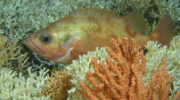 |
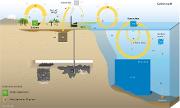 |
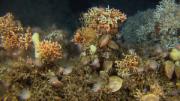 |
Provisioning services are products directly obtained from ecosystems for human use. While there is some mining of corals in other parts of the world, it is the potential use of these ecosystems that are of particular commercial interest. Organisms living in these environments have developed unique characteristics to handle the cold and the high pressure. This makes them a promising source of raw materials for industrial and pharmaceutical uses.
Regulating services are benefits obtained from regulation of ecosystem processes, for example climate regulation. It is not known how the corals contribute to this process.
Cultural services are non-material benefits obtained from ecosystems. Apart from some shallow locations where divers can enjoy cold water corals for recreational purposes, these structures are inaccessible to most people. However, the deep sea has fascinated people for centuries and is a source of a number of books and documentaries that are accessible. Because of their old age they can also be used as an archive to study historical climate change. Finally, people have stressed that these structures should be maintained, either because it is believed they are of importance for other species in the ecosystem or because people appreciate their mere existence. Others again argue that these unique ecosystems should be protected so that future generations should be able to enjoy them.
Supporting services are those necessary for the production of all other ecosystem services. Coral reefs are important habitats, providing nursery grounds and protection for a number of species including commercially important fish. The complex architecture of the corals is also the reason why we find such high biodiversity around these structures. It is reasonable to assume that this biodiversity contributes to the resilience of these systems, which is the ability they have to handle external shocks. The corals also contribute to global bio-chemical cycles through storing and circulating nutrients in the ecosystem.
 |
The total economic value framework will be used to value provisioning, regulating and cultural services, with supporting services being valued through these categories. This framework captures both use values arising from direct or indirect use of cold water corals, and non-use values related to the value of their existence or that others may benefit from them in the future. The use values include potential uses, or option values. That is the value these structures represent to future welfare in terms of processes we do not have the knowledge to value today or future uses such as development of new products. This information will give input to an ecosystem-based approach to management of marine resources both with regards to the use values of marine habitats connected to fishing activities, but also in relation to the non-use values of cold water coral habitats. |
||
PROJECT OBJECTIVES AND OPERATIONS
Coral Value has two main research objectives:
- Analyze and estimate use and non-use values of cold water corals
- Supply ecosystem-based management advice based on bio-economic modelling of habitat-fisheries interactions and a valuation study of public perceptions regarding protection of cold water corals.
Valuation of cold water corals
Valuation of cold water corals will be carried out in several steps in order to identify and estimate use and non-use values.
Ecosystem services provided by cold water corals will be identified through a literature study. A bioeconomic model will be developed to explore the interactions between fisheries and cold water coral habitats. This will give information on the indirect use value these habitats represent to Norwegian fisheries in terms of supporting fisheries production.
Using choice experiment and deliberative approaches the survey will give information on values that the public attach to cold water corals. It aims to elicit public preferences regarding management regimes of corals and give an estimate of people’s willingness to pay for protection.
Bio-economic modelling of habitat-fisheries interactions
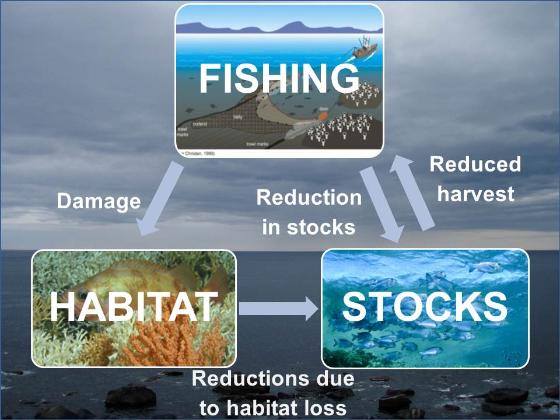 |
| Reduction in harvest resulting from fishing either directly, or through habitat destruction |
While the connection between fishing and the productivity of fish stocks is well studied and acknowledged, the role that habitat play in supporting fisheries production is not well understood. In Coral Value we will use bioeconomic models to simulate habitat-fisheries interactions for different management options. Data on the Norwegian redfish fishery will be used to study different management options, both retrospectively and in order to simulate future scenarios.
TIMEFRAME
In 2012 the project will commence with both the bioeconomic modelling and execution of the valuation survey. The survey will be the main focus the first year, but we will also start working on the bioeconomic model on habitat-fisheries connections.
The second year will focus on the analysis of the carried-out survey and development of the bioeconomic model.
In 2015, the last year of the project, the focus will be on incorporating the results from the bioeconomic model and the survey for a holistic analysis of cold water coral management.
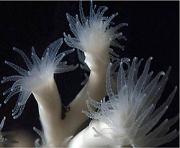 |
| Close-up of Lophelia pertusa (Photo: MAREANO/IMR) |
COLD WATER CORAL (CWC) FAQ
Did you know that:
- Most cold water corals live where there is no sunlight; between 100 to 3,000 metres deep
- Corals are small anemone-like individuals that together form a colonial organism. Living coral build upon the skeletal remains of previous generations; thus creating coral reefs.
- Norwegian fishermen used to collect cold water corals as they believed they had medicinal powers.
- Scientists explore these structures using remotely operated vehicles equipped with under-water cameras.
- The most common cold water coral in Norwegian waters ranges in colour from white to orange-red and is called Lophelia pertusa.
- Some Lophelia reefs are estimated to be 8,500 years old.
- Lophelia reefs can grow to 35 metres in height. Imagine the age of these organisms when you take into account that they only grow 4-25 mm per year!
MODERATORS IMPACT ON WILLINGNESS TO PAY
Female or male moderator – does it matter?
The project started off by conducting 24 workshops across Norway, generating attitudes towards protecting cold water corals from about 400 persons. These workshops were implemented by two female moderators. In the literature there are several tests of the effects personal characteristics, such as dressing codes, gender and language/dialect of the interviewer in person-to-person and telephone surveys. Within valuation studies we found only a handful of tests regarding interviewer effects, and these were typically on dressing code, race, and language. In each of the reported tests the authors found significant differences in calculated willingness to pay based on data collected by interviewers with different personal characteristics.
As an example, Loureiro and Lotade (2005)* found that people stated they were willing to pay significantly more for eco-labeled coffee and cocoa when interviewed by an African-American looking interviewer compared to a white-American interviewer. As far as we are aware, no such tests have been made for willingness to pay based on data collected by a discrete choice experiment. Hence, we arranged 6 workshops, identical to the original 24 with the exception that these workshops were led by a male interviewer, who were about 20 years younger than the original female interviewer.
Gender effects have not previously been tested for in valuation surveys, so we did not have any expectations with regards to how this change could influence the answers, if at all. Preliminary results indicate that there might be an interviewer effect in our data. When corrected for differences between the two samples, we were left with a significant difference in willingness to pay for cold water coral protection depending on whether the survey was led by a male or a female. Which moderator that generated the highest willingness to pay will be revealed once the study has been through a review process and published.

*Loureiro, M.L., J.Lotade (2005) Interviewer effects on the valuation of goods with ethical and environmental attributes, Environment and Resource Economics, 30, 49-72
And what do the Irish say?
Through numerous projects on the economics of the deep sea, researchers from the Norwegian College of Fishery Science have cooperated with researchers at University of Galway, Ireland. Valuation of cold water Corals (CWC) has been a particular focus of this collaboration. This Project seeks to establish the views of the Irish public with respect to measures to protect CWC and to contrast this with the views of the Norwegian public. So as part of a national survey in Ireland Jannike Falk-Andersson and Tom van Rensburg at the University of Galway undertook a series of surveys that asked the Irish Public the same questions that had been asked of the Norwegian public.
As can be seen from the map of the distribution of Irish CWCs, they are much further out at sea compared to in Norway. 180 occurrences of CWC have been recorded off the Irish coast, with the largest reef being the Logachev mounds which is 45 km in length and over 8000 years old. As in Norway the most common reef builder is the stony coral Lophelia pertusa. Note also that when you include the Exclusive Economic Zone (white line) and the continental shelf (black line) , Ireland is actually quite big!

Red dots indicate where cold water corals have been found in Irish waters (Source: CoralFish).
So, are the Irish concerned about this resource, far out at sea and located at such deep depths that they are unlikely to experience these Creatures live themselves? Well, from the response of the meetings we had in Galway, Athlone, Lahinch, Ballyhaunis, Limerick, Ballykisteen and Sligo, we do think that they have a view of how CWC should be managed. As can be seen from the map, some of these places are inland, while others are on the coast. The places we visited were diverse ranging from the university town Galway of 75 000 people, to Ballyhaunis which has a population of 3000, many of which are farmers.
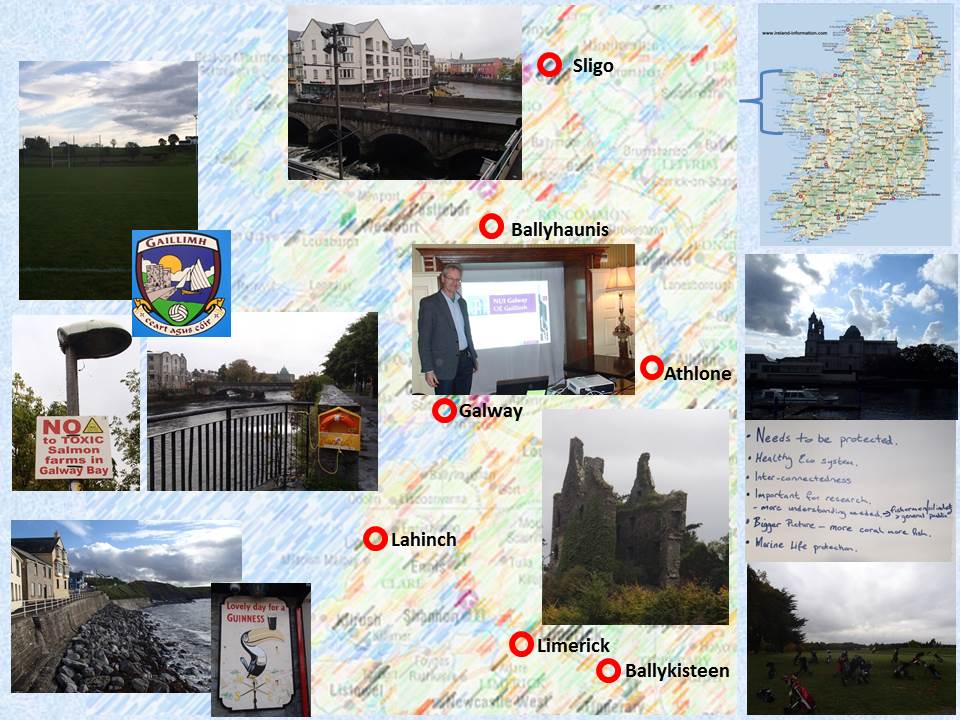
Tom van Rensburg surrounded by images of the places visited in Ireland to ask for Irish willingness to pay for protection of cold water corals.
All respondents seemed to be very intrigued by the fact that it is not only the tropics that house corals, but their cousins are also located in the deep, cold waters off the coast of Ireland. Those who came to our focus groups to share their opinions with us generally found this very interesting and left with new knowledge of Irish marine resources. Whether they are willing to pay for protection of more than the 2500 km2 of areas given special protection today to protect Irish CWC remains to be seen when the data that has been collected has been analysed Some of the participants hinted at a lack of trust in the Irish government following the financial crisis, which may affect willingness to pay through increased taxes. It will be interesting to see if these views are reflected in the full analysis to follow.
Thank you to all those who took part in the Irish survey!